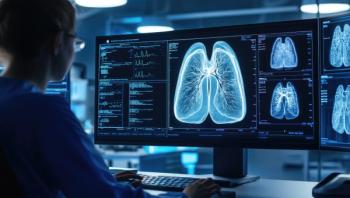
Data From Long COVID Study Could Shed Light on Pulmonary Fibrosis Causes and Treatment
Identifying the underlying causes of prolonged lung inflammation associated with radiographic abnormalities could be key understanding long COVID and other lung conditions, researchers say.
About 1 in 10 people who have had COVID-19 report experiencing lingering effects of the disease, which include brain fog and shortness of breath. There are some gray areas about how cases of what has become known as long COVID get defined and counted so that proportion sometimes reported as being much higher — up to 1 in 3. Regardless, millions of people in the U.S. have long COVID and researchers are still figuring out why and how it might be prevented and treated.
Pulmonologists at the Northwestern Medicine Comprehensive COVID-19 Center were noticing an increasing number of patients coming in with long COVID symptoms with abnormal CT scans of their lungs.
Observing that some would be left with scar tissue and others would recover, the pulmonologists wanted to explore this further. They named this phenomenon “respiratory post-acute sequelae of COVID-19 (PASC) with radiographic abnormalities (RPRA).”
The Northwestern team then teamed up with researchers at Brigham and Women’s Hospital in Boston, Ohio State University and Duke University to conduct CT scan analysis to determine which cells and molecules were responsible for radiographic abnormalities in these patients, believing it could lead to possible treatment options.
The results of the study, published in Nature Immunology in early October 2024, opens up the possibility that long COVID patients with abnormal lung CT scans may unlock a key to preventing pulmonary fibrosis in the future.
The researchers used data from a cohort of 35 patients with RPRA who took part in an observational study at Northwestern Medicine between November 2020 and May 2022. Each of the participants underwent a CT scan before or at the time of enrollment, with 29 getting a follow-up scan. Additionally, all 35 displayed respiratory symptoms, be it a cough (69%)or shortness of breath (97%), and displayed abnormal lung tissue on their CT scans.
Of the 35, 43% required oxygen therapy after their original COVID diagnosis, 17 were admitted to the IC unit, 26 in all were hospitalized and two underwent lung transplantation. Nine had no serious symptoms requiring a hospital stay.
Next the researchers looked at the similarities for those whose lungs improved and showed no signs of improvement, and conducted additional analysis by looking at previous studies dealing with those who required lung transplantation after COVID, and patients who had idiopathic pulmonary fibrosis.
Among the key findings were that in the CT scans done 145 days after COVID infection, 39% showed pulmonary fibrosis and 22% inflammatory changes. Additionally, samples from lung fluid on a subset of these patients an average of 5.3 months showed high levels of pro-inflammatory molecules leading to ongoing immune cell migration into their lungs.
In the paper, the study authors wrote they saw a “persistent migration of white blood cells (including neutrophils and monocytes) in the lungs of people with radiographic abnormalities that was correlated with the severity of CT scan changes.”
What’s more, patients with radiographic abnormalities that improved, worsened or remained the same all had similar monocyte-derived alveolar macrophages, which the researchers supported by comparing these molecular characteristics to samples from patients who had end-stage pulmonary fibrosis from COVID and idiopathic pulmonary fibrosis.
The research team asserts that identifying the underlying causes of prolonged lung inflammation associated with radiographic abnormalities is crucial in tackling long COVID. Their study, they said, shows that understanding effects of COVID-19 could yield insights into other chronic respiratory conditions that result in pulmonary fibrosis, ultimately aiding the search for improved medical treatments.
Newsletter
Get the latest industry news, event updates, and more from Managed healthcare Executive.


















































